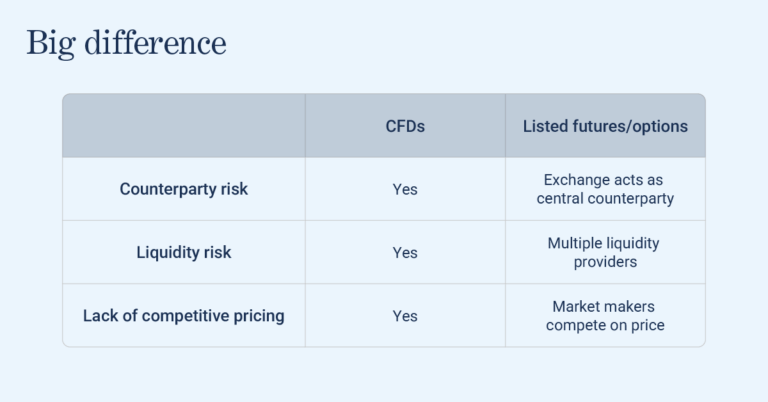Latest CFD bans threaten listed products

Recent CFD regulations in Germany and Spain have taken troubling turns. The new measures appear to conflate products like contracts-for-difference with instruments like futures and options. But listed instruments reduce or eliminate many of the risks buyers of CFDs are exposed to, and their use should be encouraged, not curtailed.
Regulators have long trained their sights on a type of derivative frequently marketed to retail investors, which allows them to take leveraged bets on assets like currencies, stocks and commodities. Contracts-for-difference, or CFDs, have been the target of marketing restrictions around the world, even outright bans in places like the US.
But recent CFD regulations in Germany and Spain have taken new – and in some ways troubling – turns. The thrust of the Spanish measures, introduced this year, is to extend their CFD regulation to futures and options, with the justification that potential losses in those products may be large or uncertain. Meanwhile, Germany last year proposed rules broadening its CFD ban to futures contracts traded on margin.
We support regulatory scrutiny around the marketing and trading of CFDs. What we are concerned about is the trend of conflating products like CFDs with instruments like futures and options.
With these recent measures, regulators risk stigmatizing instruments that could form the backbone of a safer, more sustainable retail trading culture in Europe. Exchange-listed products ameliorate many of the hazards associated with CFDs, such as liquidity risk and counterparty risk, while also increasing competition in pricing. Lumping them together with CFDs could form a worrying precedent for Europe’s capital markets.

Source: Optiver
CFDs versus listed
Like other derivatives, CFDs allow investors to bet on price movements in an asset without actually owning it. The attractions of CFDs are various: lower margin requirements compared with other instruments, tax advantages, the availability of 24/7 trading, simplified access to local and global markets, and low to non-existent fees.
CFDs are typically bought and sold on margin, similar to listed derivatives, meaning traders need only deposit a fraction of the trade’s value to open a position. Unlike most derivatives however, CFDs typically don’t have an expiry date, so the position can be held in perpetuity.
The UK FCA estimates 80% of customers lose money on CFDs, while close to 75% of retail investors in Spain do, according to the CNMV. For the typical Spanish client, these losses range from €1,649 to €7,269. This hasn’t prevented retail trading of unlisted derivatives (of which CFDs make up the largest share) from increasing 26% in 2021 compared with the previous year in Spain, according to the CNMV. They’re on the rise in Germany too, data from CFD Verband shows. No wonder authorities are concerned.
While the losses suffered by investors in these products is cause for worry, we believe most of the dangers inherent in these instruments come from the fact that they are unlisted. Instruments like futures and options, by contrast, can remove many of these risks. Here are three key differences between CFDs and listed futures and options that show why regulators should consider the above points when contemplating any approach that groups them together:
- Price Competition. CFDs aren’t listed on exchange, so there’s no competition to improve prices. Instead, there’s typically only one price, set by the issuer, who usually also acts as broker and sole liquidity provider. There’s a conflict of interest when the broker is both the issuer of the product and the only available counterparty. Products listed on exchange by contrast usually have multiple market makers competing to provide quotes. Greater competition leads to tighter spreads, which lead to better prices for investors.
- Liquidity Risk. Because CFDs are sold by brokers and do not trade on exchange, there may not always be a buyer or seller available, especially in volatile markets. Listed products like options and futures mitigate this risk because multiple liquidity providers stand ready to buy and sell, even during volatile conditions.
- Counterparty Risk. CFDs are issued by a broker or other provider, and the obligation to pay out on the contract sits with them. However, this might not be possible if the broker faces financial difficulties or goes bankrupt. Investors in these situations typically have limited recourse. With listed derivatives like futures and options, exchanges act as central counterparties, meaning each side to a trade faces the exchange. As a result, the exchange will step in to meet the obligations under the instrument if either side falls into difficulty.
Optiver agrees that regulators should act to protect investors from the negative characteristics of products such as CFDs. However we question a regulatory approach that conflates CFDs with products such as listed futures and options. These instruments reduce or eliminate many of the risks buyers of CFDs are exposed to. Their use should be encouraged, not curtailed.
Further reading
- An explainer about futures contracts.
- An article about mis-selling of CFDs.
- A bulletin about the German proposals for regulating futures.
- An FCA consultation paper about CFDs.
To discuss this paper – or any other market structure topic – reach out to the Optiver Corporate Strategy team at [email protected]
DISCLAIMER: Optiver V.O.F. or “Optiver” is a market maker licensed by the Dutch authority for the financial markets to conduct the investment activity of dealing on own account. This communication and all information contained herein does not constitute investment advice, investment research, financial analysis, or constitute any activity other than dealing on own account.





